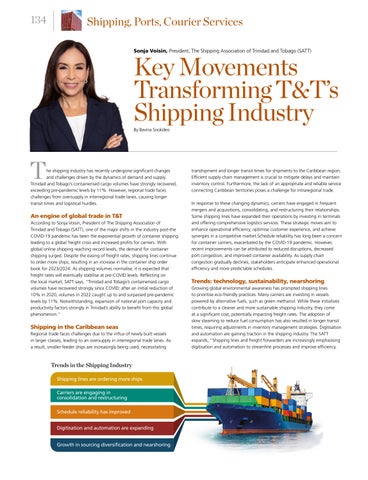134
Shipping, Ports, Courier Services
Key Movements Transforming T&T’s Shipping Industry Sonja Voisin, President, The Shipping Association of Trinidad and Tobago (SATT)
By Bavina Sookdeo
T
he shipping industry has recently undergone significant changes and challenges driven by the dynamics of demand and supply. Trinidad and Tobago’s containerised cargo volumes have strongly recovered, exceeding pre-pandemic levels by 11%. However, regional trade faces challenges from oversupply in interregional trade lanes, causing longer transit times and logistical hurdles.
An engine of global trade in T&T According to Sonja Voisin, President of The Shipping Association of Trinidad and Tobago (SATT), one of the major shifts in the industry post-the COVID-19 pandemic has been the exponential growth of container shipping leading to a global freight crisis and increased profits for carriers. With global online shipping reaching record levels, the demand for container shipping surged. Despite the easing of freight rates, shipping lines continue to order more ships, resulting in an increase in the container ship order book for 2023/2024. As shipping volumes normalise, it is expected that freight rates will eventually stabilise at pre-COVID levels. Reflecting on the local market, SATT says, “Trinidad and Tobago’s containerised cargo volumes have recovered strongly since COVID; after an initial reduction of 10% in 2020, volumes in 2022 caught up to and surpassed pre-pandemic levels by 11%. Notwithstanding, expansion of national port capacity and productivity factors strongly in Trinidad’s ability to benefit from this global phenomenon.”
Shipping in the Caribbean seas Regional trade faces challenges due to the influx of newly built vessels in larger classes, leading to an oversupply in interregional trade lanes. As a result, smaller feeder ships are increasingly being used, necessitating
transhipment and longer transit times for shipments to the Caribbean region. Efficient supply chain management is crucial to mitigate delays and maintain inventory control. Furthermore, the lack of an appropriate and reliable service connecting Caribbean territories poses a challenge for intraregional trade. In response to these changing dynamics, carriers have engaged in frequent mergers and acquisitions, consolidating, and restructuring their relationships. Some shipping lines have expanded their operations by investing in terminals and offering comprehensive logistics services. These strategic moves aim to enhance operational efficiency, optimise customer experience, and achieve synergies in a competitive market.Schedule reliability has long been a concern for container carriers, exacerbated by the COVID-19 pandemic. However, recent improvements can be attributed to reduced disruptions, decreased port congestion, and improved container availability. As supply chain congestion gradually declines, stakeholders anticipate enhanced operational efficiency and more predictable schedules.
Trends: technology, sustainability, nearshoring Growing global environmental awareness has prompted shipping lines to prioritise eco-friendly practices. Many carriers are investing in vessels powered by alternative fuels, such as green methanol. While these initiatives contribute to a cleaner and more sustainable shipping industry, they come at a significant cost, potentially impacting freight rates. The adoption of slow steaming to reduce fuel consumption has also resulted in longer transit times, requiring adjustments in inventory management strategies. Digitisation and automation are gaining traction in the shipping industry. The SATT expands, “Shipping lines and freight forwarders are increasingly emphasising digitisation and automation to streamline processes and improve efficiency.
